The allure of the majestic Himalayas, combined with the promise of a breathtaking panorama at the Annapurna Base Camp, beckons adventurers from around the world to embark on the Annapurna Base Camp Trek. But like all high-altitude excursions, it comes with its set of challenges and concerns. Among the most frequently pondered questions is: "Is it safe to trek to Annapurna Base Camp?" The answer is multifaceted, depending on several variables ranging from individual preparation to external factors. In this comprehensive guide, we'll shed light on the safety aspects of the trek, ensuring that you are well-informed and equipped to make your journey not only memorable but also safe. Whether it's the potential threat of altitude sickness, trail conditions, or the unpredictability of mountain weather, we've got you covered. As you prepare to tread the paths once walked by seasoned trekkers and passionate novices alike, let's dive into understanding the safety measures one should consider for a secure trekking experience in the Annapurna region.

Altitude Sickness and Acclimatization
One of the primary concerns while trekking in the high-altitude regions of the Himalayas is the potential for altitude sickness, also known as Acute Mountain Sickness (AMS). Let’s understand its implications and preventive measures for trekkers embarking on the Annapurna Base Camp journey.
What is Altitude Sickness? Altitude sickness occurs when trekkers ascend to great heights too quickly, preventing their bodies from adjusting to reduced oxygen levels and decreased atmospheric pressure. Symptoms might range from mild to severe and can include headaches, dizziness, nausea, shortness of breath, and insomnia.
Risk on the Annapurna Base Camp Trek: The Annapurna Base Camp is situated at an altitude of approximately 4,130 meters. While this is lower than some of the other renowned trekking peaks, the risk of altitude sickness still exists, especially as you ascend beyond 2,500 meters.
Preventing Altitude Sickness:
- Gradual Ascent: It's crucial to ascend slowly, allowing your body ample time to acclimatize. Most well-planned itineraries, such as those provided by Luxury Holidays Nepal, incorporate acclimatization days.
- Stay Hydrated: Drinking ample water can aid in better acclimatization. Aim for 3-4 liters a day, but avoid excessive alcohol or caffeine.
- Know the Symptoms: Being aware of the early signs of altitude sickness can help in timely intervention.
- Descend if Needed: If symptoms become severe, it’s essential to descend to a lower altitude.
- Medication: Some trekkers opt for medicines like Diamox to prevent AMS. However, it’s vital to consult with a doctor before taking any medication.
Importance of Acclimatization: Acclimatization is the process by which the body adjusts to the decrease in oxygen concentration at a higher altitude. Proper acclimatization reduces the risk of AMS and ensures that trekkers can enjoy the journey without health concerns. Taking rest days, sleeping at lower elevations than the highest point reached during the day, and not ascending more than 500 meters in a day after crossing the 3,000-meter mark are good acclimatization practices.
While the Annapurna Base Camp Trek is an exhilarating experience, it’s paramount to approach it with caution and respect for the body’s needs. Understanding the risks of altitude sickness and emphasizing acclimatization can ensure a safer and more enjoyable journey.
Trekking with a Guide
The prospect of trekking in the grandeur of the Himalayas, especially along the renowned Annapurna Base Camp route, can often be both exhilarating and intimidating. The dilemma faced by many trekkers, especially those unfamiliar with the region, is whether to hire a guide or brave the trail independently. In this section, we delve into the safety implications of trekking with a guide.
Why Consider Hiring a Guide?
- Expertise in Navigation: The trails to Annapurna Base Camp are well-trodden but can be complex in some areas. A seasoned guide, familiar with every nook and cranny of the trail, ensures you don't veer off the path.
- Local Knowledge: With their extensive local knowledge, guides can provide insight into the culture, history, and traditions of the communities you pass, enriching your trekking experience.
- Language Barrier: Communication in remote villages can be challenging if you don't speak Nepali. A guide bridges the language gap, ensuring smooth interactions with the locals.
- Emergency Situations: In case of accidents, health issues, or natural calamities, having a guide can be a lifesaver. They are trained to handle emergencies and can make critical decisions promptly.
- Liaison with Authorities: From checkpoint registrations to permit verifications, a guide will handle all interactions, ensuring hassle-free passage.
Choosing the Right Guide: If you've decided to hire a guide, ensure you choose a reputable one. Companies like Luxury Holidays Nepal provide experienced and trained guides for the Annapurna Base Camp trek. Here are a few points to consider:
- Certification: Ensure the guide is certified by local trekking associations.
- Experience: An experienced guide can make a significant difference in ensuring safety and enriching your trekking experience.
- Language Skills: Choose a guide proficient in your language to ensure effective communication.
- First Aid Training: This can be an added advantage in case of minor injuries or health issues during the trek.
Cost Implications: While hiring a guide involves additional costs, it's a worthy investment in safety, security, and a richer trekking experience. The cost typically covers the guide's daily fee, meals, accommodation, insurance, and transportation.
Trekking to Annapurna Base Camp with a guide offers an added layer of safety, convenience, and depth to your journey. While seasoned trekkers may opt for solo journeys, for those unfamiliar with the region or trekking at such altitudes, a guide can make a world of difference.
Weather Challenges
The allure of the majestic Annapurna Base Camp Trek, with its picturesque landscapes, often comes with the unpredictability of high-altitude weather. Understanding the weather challenges and being adequately prepared is key to ensuring a safe trekking experience.
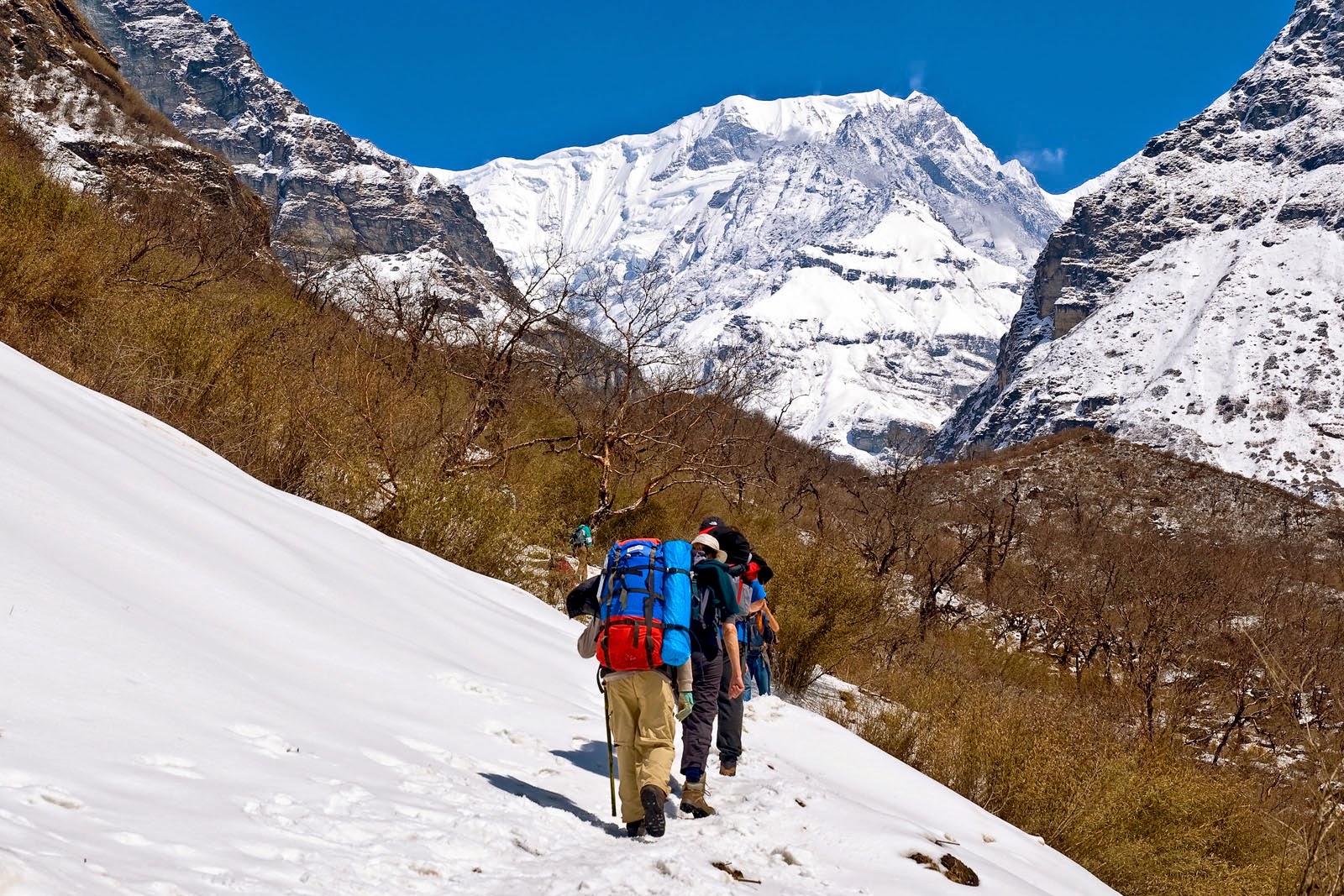
Weather Dynamics in the Himalayas
Variability: The Himalayan weather is notorious for its quick shifts. It's not uncommon to experience sunshine, rain, and snow all in a single day's trek.
Seasonal Changes: The Annapurna Base Camp trek can be approached year-round, but each season offers its unique challenges:
- Spring (March to May): Warm days, but nights can be chilly. It's also the blooming season, making the trek visually delightful.
- Monsoon (June to August): The trail can be slippery due to rainfall, and there’s an increased risk of landslides. However, the rain clears the sky, offering some of the best mountain views.
- Autumn (September to November): Clear skies and moderate temperatures make it the most popular trekking season. But it also means crowded trails.
- Winter (December to February): Cold and snowy conditions. The trail can be challenging, but it offers solitude and stunning snowy landscapes.
Weather-Related Challenges
- Unexpected Rainfall: This can lead to slippery trails, making the descent especially treacherous.
- Snowfall: Unexpected snowfall can block passes and make paths difficult to navigate.
- Temperature Drops: The high-altitude regions can get exceptionally cold, especially during night and early mornings.
- Fog and Reduced Visibility: This can be disorienting, increasing the risk of going off-trail.
Preparation and Safety Tips
- Stay Updated: Check weather forecasts frequently. While not always 100% accurate, they can give a general idea of what to expect.
- Quality Gear: Waterproof and warm trekking gear, including quality boots, is essential.
- Flexibility: Always have a buffer day or two in your itinerary. If the weather turns bad, it's safer to wait it out than to push through.
- Trek with a Guide: As emphasized earlier, a local guide, familiar with the terrain and weather patterns, can advise on the safest course of action.
- Know When to Turn Back: If conditions deteriorate, it might be safer to descend or wait for the weather to improve.
While the Annapurna Base Camp trek offers unparalleled beauty, the weather challenges mandate respect and preparation. Being well-informed and equipped can make the difference between a memorable trekking experience and an unsafe one.
Trail Conditions
Embarking on the Annapurna Base Camp trek is a dream for many adventure enthusiasts. While its breathtaking vistas and unique cultural experiences are undoubtedly enticing, understanding the trail conditions is crucial for ensuring a safe journey.
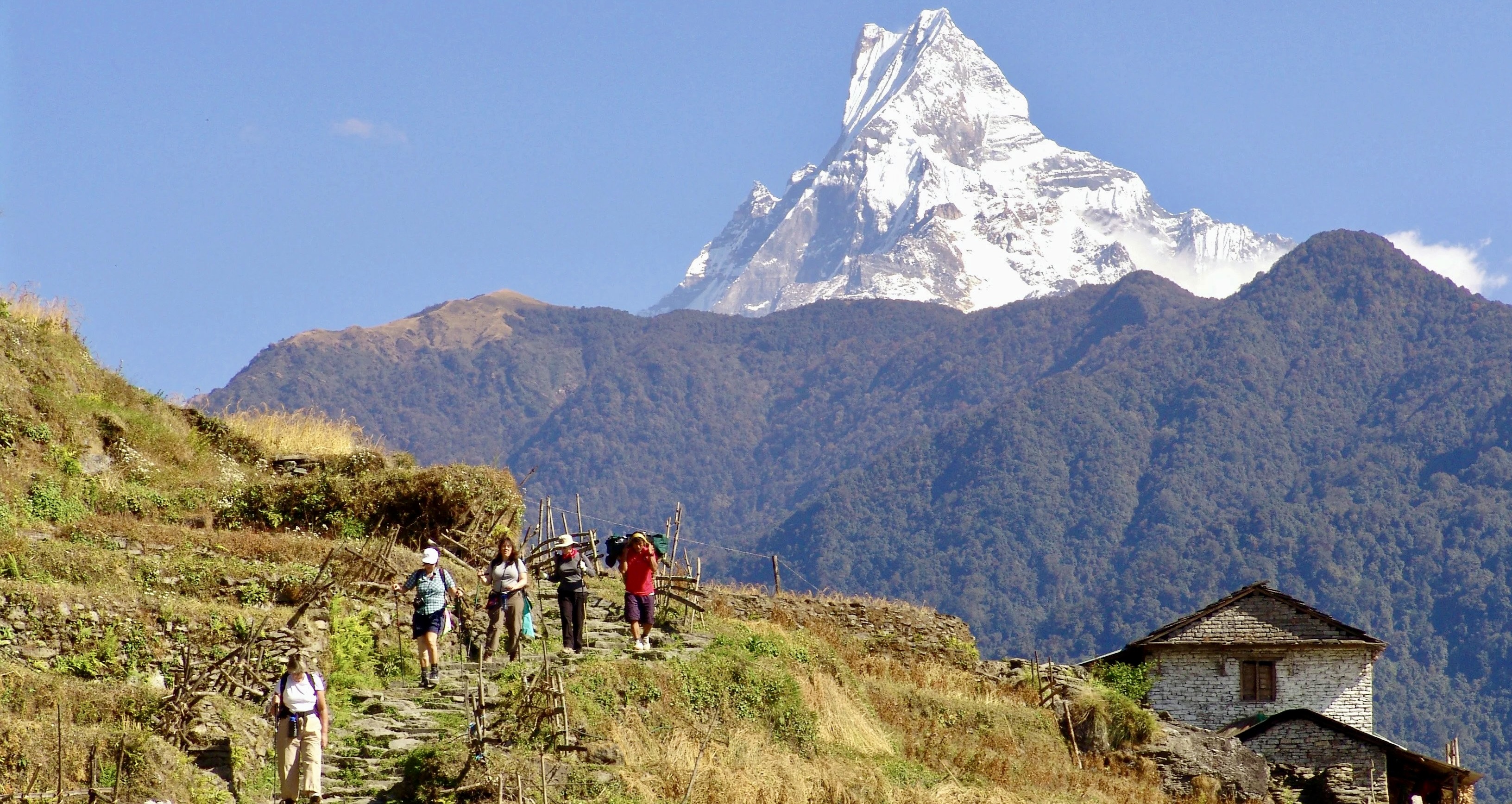
Overview of the Trail: The Annapurna Base Camp trail winds through diverse terrains, starting from subtropical forests and paddy fields to alpine landscapes and snowy expanses. Each section presents its set of challenges.
Key Trail Conditions to Consider:
- Path Structure: The majority of the Annapurna Base Camp trail is well-trodden and marked. However, certain segments, especially around landslide-prone areas, can be rugged and uneven.
- Landslides and Rockfalls: Some sections, particularly during the monsoon season, are susceptible to landslides. This not only makes the trail risky but can also lead to temporary blockages.
- River Crossings: There are numerous bridge crossings over rivers. While most of these bridges are sturdy, some can be narrow and high, inducing vertigo in trekkers not used to heights.
- Snow and Ice: At higher altitudes, especially during the winter and early spring, trails can be snow-covered or icy, making them slippery and challenging to navigate.
- Steep Ascents and Descents: The trek includes sections with steep climbs, which can be strenuous, and descents, which can be hard on the knees.
Safety Tips and Precautions:
- Trekking Poles: A pair of good trekking poles can aid in balance, especially during descents and in slippery conditions.
- Proper Footwear: It's crucial to invest in sturdy, well-fitting trekking boots with a good grip to handle diverse trail conditions.
- Stay Alert: Always be aware of your surroundings. Listen for sounds that might indicate an impending rockfall or landslide.
- Follow Local Advice: Locals and guides have invaluable knowledge about trail conditions, recent landslides, or areas to avoid.
- Avoid Night Trekking: It's advisable to reach your destination before dusk. Trekking in the dark increases the risk of accidents, especially on unfamiliar terrain.
- Travel with a Group or Guide: Especially if you're unfamiliar with the region, trekking with a group or hiring a guide from trusted agencies like Luxury Holidays Nepal can enhance safety.
The Annapurna Base Camp trek, while offering some of the most stunning visuals of the Himalayas, requires trekkers to be aware of the varying trail conditions. Preparedness, the right equipment, and heeding local advice are paramount for a safe trekking experience.
Wildlife Encounters
Nestled in the lap of the Himalayas, the Annapurna Base Camp trek isn't just about mesmerizing mountain views; it also brings trekkers closer to the region's rich biodiversity. Encountering wildlife can be an exhilarating experience, but it's essential to remember the safety protocols, ensuring the well-being of both trekkers and the animals.
Wildlife in the Annapurna Region
- Mammals: Some of the mammals trekkers might spot include langurs, Himalayan tahr, musk deer, and on rare occasions, the elusive snow leopard.
- Birds: The region is home to various bird species, from the impressive bearded vulture to the colorful monal, Nepal's national bird.
- Smaller Creatures: Be aware of smaller fauna such as leeches during the monsoon season and various types of insects.
Safety Concerns and Tips for Wildlife Encounters
- Maintain a Safe Distance: As enchanting as it might be to see wild animals up close, always maintain a respectful and safe distance. Animals can be unpredictable, especially if they feel threatened.
- Avoid Feeding Wildlife: Feeding animals might seem harmless, but it can cause them to become dependent on human food, and they might also become aggressive if they expect food and don't get it.
- Stay Calm: If you encounter a larger mammal, avoid making sudden movements or loud noises. Instead, stay calm and slowly move away without turning your back on the animal.
- Be Leech Savvy: During the rainy season, leeches can be a nuisance. Wear long pants, use insect repellents, and regularly check for leeches. If you find one latched on, don't pull it off, but apply salt or insect repellent to make it let go.
- Stick to the Trail: Most animals steer clear of well-trodden paths. By sticking to the trail, you reduce the risk of unexpected encounters.
- Listen to Local Guides: If you're trekking with a guide from agencies like Luxury Holidays Nepal, heed their advice. They have a wealth of knowledge about local wildlife and can provide insights and safety tips.
- Campsite Precautions: When camping, store food securely and dispose of waste responsibly. Animals are often drawn to campsites by the smell of food.
Wildlife encounters on the Annapurna Base Camp trek can be one of the highlights of the journey. However, it's crucial to approach these experiences with respect and caution. By following safety guidelines, trekkers can enjoy the beauty of nature while ensuring that they don't disturb the natural balance of the ecosystem.
Local Customs and Respect
The Annapurna Base Camp (ABC) trek isn't just a journey through breathtaking landscapes; it's also a cultural immersion into the lives of the local communities living in the shadows of the towering Annapurnas. Respecting local customs and traditions plays a pivotal role in ensuring your safety and fostering meaningful interactions with the locals.
Understanding the Culture
The Annapurna region is predominantly inhabited by two major ethnic groups: the Gurungs and the Magars. They have their own distinct languages, customs, and traditions, yet there are shared cultural norms that trekkers should be aware of.
Key Customs and Tips to Ensure Safety through Respect
- Dress Modestly: Nepalese communities are generally conservative when it comes to clothing. It's advised to wear long pants and avoid sleeveless tops. This is especially crucial for women to avoid drawing unnecessary attention or causing offense.
- Show Respect in Religious Places: When visiting monasteries, temples, or chortens, always walk clockwise around them. Remove your shoes when entering religious buildings, and always ask for permission before taking photos.
- Greetings: A simple "Namaste" (with palms pressed together) is the traditional way of greeting, which means "I salute the divine in you." It's a gesture that is always appreciated.
- Refrain from Public Displays of Affection: Holding hands might be acceptable, but hugging and kissing in public are frowned upon in Nepali culture.
- Respect Local Etiquette at Meal Times: Before you start eating, it's customary to say "Bhojan gariyos," which means "Let's eat." If offered food or drink, it's polite to accept, even if it's just a small token amount.
- Avoid Controversial Topics: Avoid discussing sensitive topics like politics or regional conflicts. The political landscape in Nepal can be quite complex, and it's best to listen rather than express strong opinions.
- Seek Permission: Before photographing people, especially the elderly, always ask for their permission. Some locals might believe that capturing their image could capture their soul.
- Support Local: Buy local products or services and respect the prices. Haggling is customary, but do it respectfully without being excessively frugal. This supports the local economy and fosters goodwill.
- Choose Responsible Tour Operators: Going with reputable companies like Luxury Holidays Nepal ensures that you're traveling in a way that respects local customs, traditions, and the environment.
Safety on the Annapurna Base Camp trek isn't just about navigating physical challenges; it's also about ensuring respectful and harmonious interactions with the local communities. By understanding and respecting local customs, trekkers can ensure a more enriching and safer trekking experience, making the journey memorable for all the right reasons.
Health and Hygiene
Trekking in the wilderness, away from the comforts of urban life, has its own set of health and hygiene challenges. The Annapurna Base Camp (ABC) trek, while enthralling, demands careful attention to health and sanitation practices. Here's how you can safeguard your health while trekking and ensure a safe journey.
Water Purification and Consumption
- Stay Hydrated: Drinking ample water is crucial, especially at high altitudes, to prevent dehydration and aid acclimatization.
- Purify Your Water: While there are tea houses along the ABC trek that sell bottled water, it's environmentally responsible to use reusable water bottles. Use water purification tablets or portable water purifiers to treat local tap or spring water.
- Avoid Ice: Never consume ice in your drinks, as it might be made from untreated water.
Food Safety
- Eat Freshly Cooked Meals: Always opt for food that is freshly cooked and served hot. This minimizes the risk of bacterial contamination.
- Avoid Raw Foods: While salads and uncooked foods might look tempting, they could be a source of gastrointestinal illnesses. Stick to cooked vegetables and peeled fruits.
- Be Wary of Meat: With no refrigeration in many places, the freshness of meat can be questionable. Vegetarian meals are a safer bet.
Personal Hygiene
- Hand Sanitizers: Always carry and frequently use hand sanitizers, especially before meals.
- Wet Wipes: Useful for a quick face or hand clean when water is scarce.
- Toilet Paper: Many tea houses and lodges might not provide toilet paper, so it's wise to keep a roll in your backpack.
- Personal First Aid Kit: Include essentials like adhesive bandages, antiseptic wipes, anti-diarrheal medicine, pain relievers, and any personal medication.
Avoiding Altitude Sickness
- Acclimatize: Listen to your body, and give it time to adjust to the increasing altitudes. It's advisable to have rest days or climb slowly to reduce the risk of altitude sickness.
- Diamox: Some trekkers use Diamox to help with acclimatization. However, consult with a doctor before taking any medication.
Vaccinations and Pre-trek Health Check
- Visit Your Doctor: Before embarking on your trek, consult with your doctor about the necessary vaccinations such as Hepatitis A, Typhoid, and Tetanus.
- Travel Insurance: Ensure you have travel insurance that covers trekking at high altitudes and potential evacuation costs.
Being prepared and vigilant about health and hygiene can greatly enhance your ABC trek experience. The Himalayas are there to be enjoyed, but it's essential to prioritize your well-being to truly soak in the beauty of the Annapurna region. With the right precautions, you're set for an exhilarating, safe journey.
Insurance
Ensuring your safety while trekking to Annapurna Base Camp (ABC) goes beyond just physical preparations and being aware of the terrain. One of the most overlooked, yet vital, aspects of trekking safety is securing the right insurance coverage. Let's delve into why insurance is essential for ABC trekkers and what to look for when purchasing a policy.
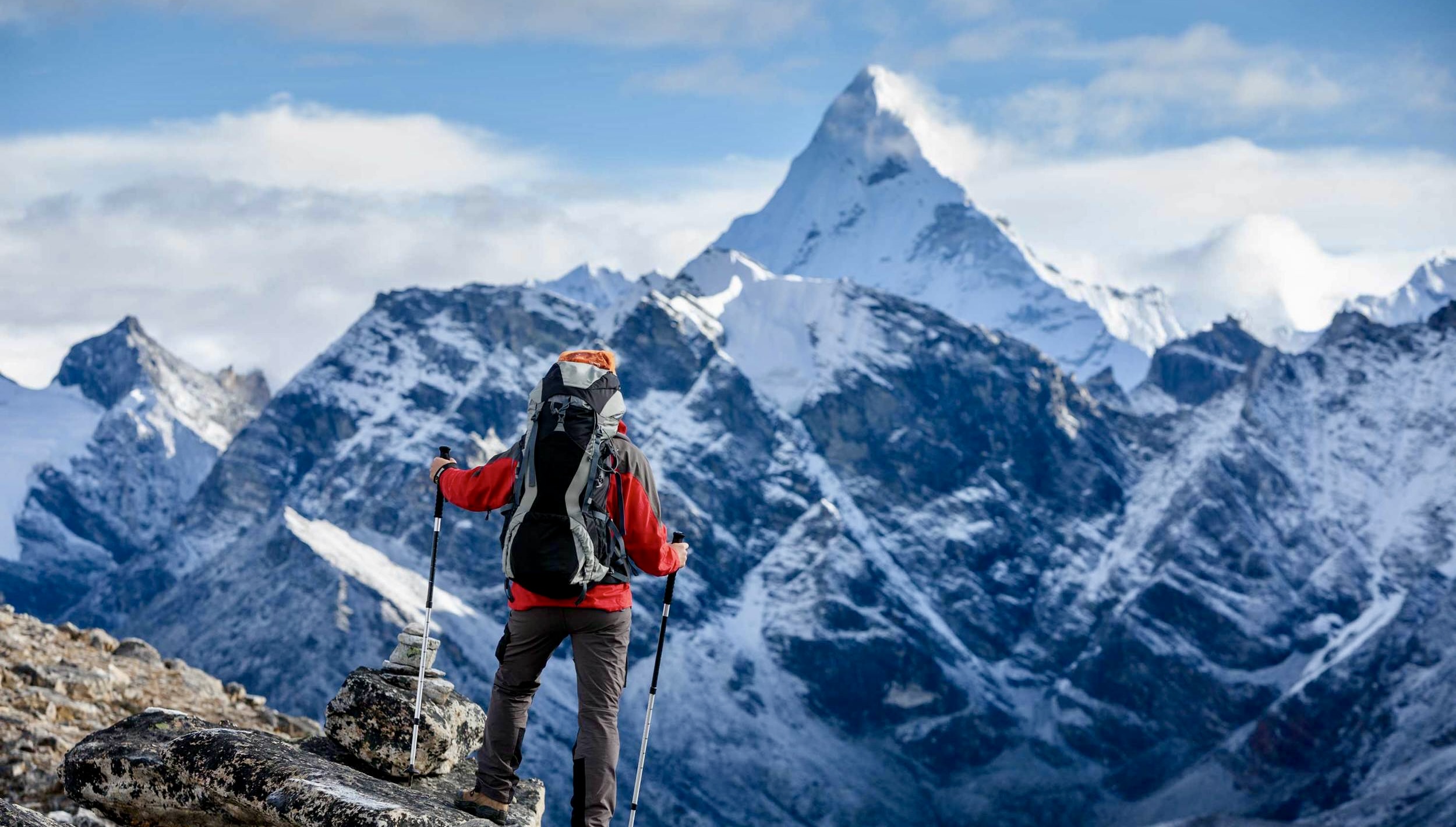
The Importance of Travel Insurance for ABC Trek
- High Altitude Risks: Trekking to ABC means navigating high altitudes, where the risk of Acute Mountain Sickness (AMS) is prevalent. In severe cases, an immediate descent or evacuation may be necessary, and having insurance can be a lifesaver.
- Medical Emergencies: From minor injuries to more severe conditions, having an insurance policy that covers medical emergencies ensures you receive the best care without the financial burden.
- Unexpected Delays or Cancellations: Factors like adverse weather conditions, political unrest, or personal emergencies can disrupt your plans. Insurance can help recoup lost expenses.
Key Components of Good Trekking Insurance
- High Altitude Coverage: Ensure the policy covers treks up to the altitude of ABC, which is 4,130 meters. Some standard policies might not cover activities at such elevations.
- Helicopter Evacuation: In case of severe altitude sickness or injuries where the terrain is challenging, helicopter evacuations are the most effective way to transport a patient. Ensure your policy covers the cost of a potential helicopter rescue.
- Medical Coverage: Apart from evacuation, your insurance should cover hospital charges, doctor fees, and other medical expenses.
- Trip Cancellation and Curtailment: If you need to cancel your trek or cut it short, this coverage will ensure you're compensated for any non-refundable expenses.
- Loss or Theft: The policy should cover the loss or theft of your belongings, including important documents, equipment, or cash.
- Repatriation: In extreme circumstances, it might be necessary to be sent home for medical reasons. Ensure your policy covers the cost of repatriation.
Choosing the Right Provider
- Reputation: Look for insurance providers with positive reviews, especially from fellow trekkers.
- Clear Terms: Make sure the terms and conditions, especially exclusions, are clearly mentioned and understood.
- 24/7 Assistance: Opt for a provider that offers round-the-clock support, crucial in case of emergencies in different time zones.
Trekking to ABC is a thrilling adventure, but the unpredictable nature of the journey demands a safety net. While we all hope never to use our insurance, having a comprehensive policy ensures peace of mind, allowing you to focus on the beauty of the Annapurna region.
Total Distance of Annapurna Base Camp Trek
The Annapurna Base Camp (ABC) Trek, fondly known as the "Annapurna Sanctuary Trek," is a favorite amongst trekking enthusiasts. The journey to the base of the 10th highest mountain in the world offers a unique blend of culture, breathtaking landscapes, and the exhilaration of trekking in the Himalayas. But how far will your feet carry you on this unforgettable journey?
Starting Point – End Point:
Typically, trekkers start the ABC Trek from Nayapul, which is a short drive from Pokhara, the second-largest city in Nepal. The trek culminates at the Annapurna Base Camp and returns via a similar or slightly varied route.
Total Distance:
The total distance of the Annapurna Base Camp Trek varies depending on the exact route taken and where side trips or extra acclimatization days are added. However, on average, the round-trip distance from Nayapul to Annapurna Base Camp and back is approximately 110-130 kilometers (68-80 miles).
Breakdown by Days:
Here's a general breakdown of the distances covered each day, based on a popular 10-day itinerary:
- Nayapul to Tikhedhunga: ~9 km
- Tikhedhunga to Ghorepani: ~13 km
- Ghorepani to Tadapani (after the morning Poon Hill excursion): ~12 km
- Tadapani to Chhomrong: ~10 km
- Chhomrong to Dovan: ~11 km
- Dovan to Machapuchare Base Camp (MBC): ~11 km
- MBC to Annapurna Base Camp (ABC): ~4 km
- ABC to Bamboo: ~15 km
- Bamboo to Jhinu Danda: ~12 km
- Jhinu Danda to Nayapul: ~20 km
Note: Distances can vary based on the specific trail taken, as there are multiple routes to reach certain destinations. This is a general estimation and can be longer or shorter based on side trips, rest days, and other factors.
The Annapurna Base Camp Trek's total distance may seem daunting, but the trek is spread over several days, allowing trekkers to soak in the views, acclimatize properly, and truly enjoy the experience. Regardless of the exact distance, the journey through the diverse landscapes, from terraced farmlands to alpine forests and the magnificent Annapurna Sanctuary, makes every step worthwhile.
Annapurna Circuit Trek vs. Annapurna Base Camp
Nepal, a land blessed with some of the world's highest peaks, presents trekkers with a plethora of options. Two of the most renowned treks in the Annapurna region are the Annapurna Circuit Trek and the Annapurna Base Camp Trek. While both offer mesmerizing views of the majestic Annapurna range, they provide unique experiences. In this article, we'll compare the two, helping you make an informed decision about which trek is right for you.
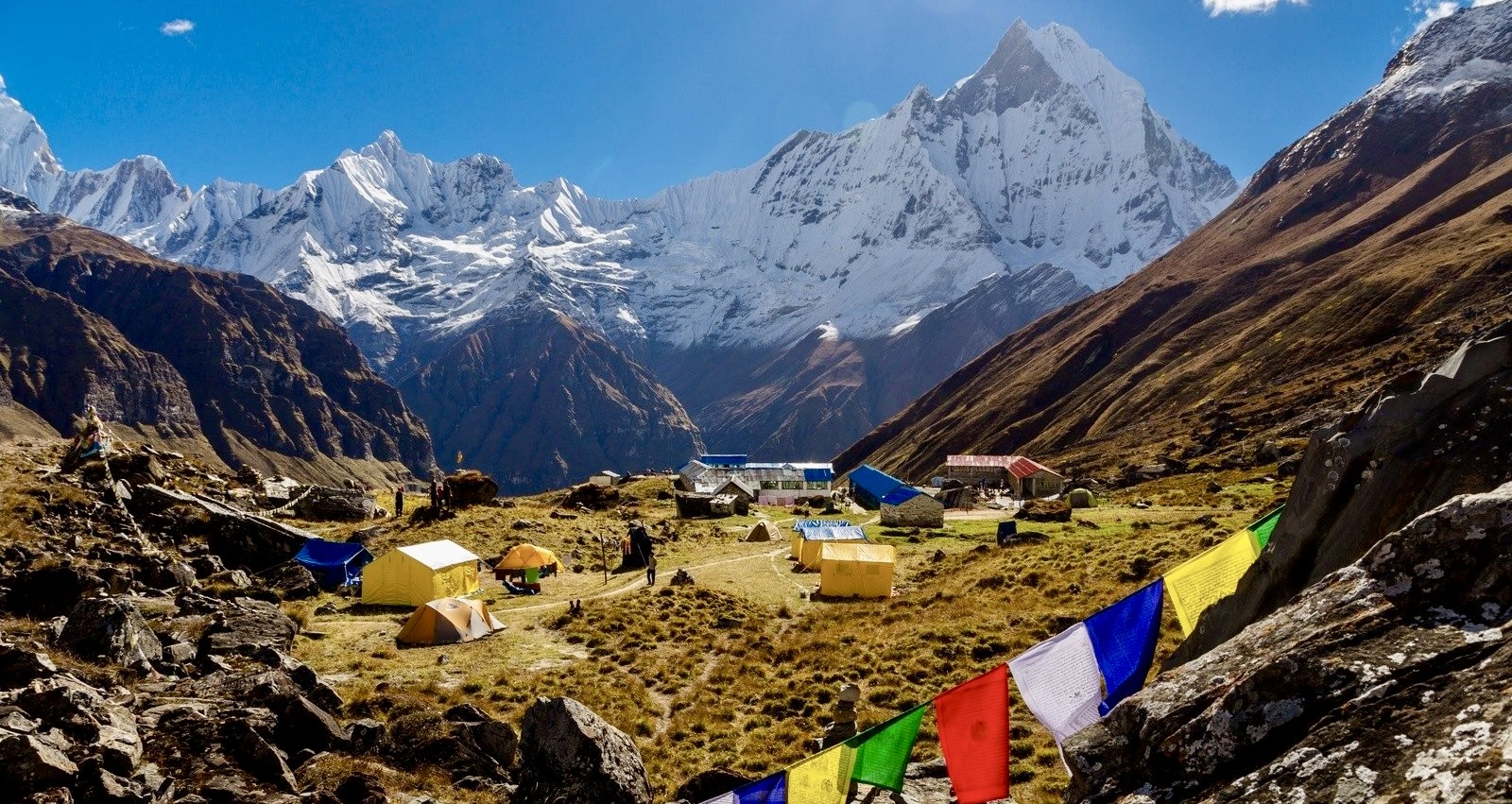
1. Duration and Distance:
- Annapurna Circuit Trek: Typically takes 15-21 days and covers around 160-230 kilometers, depending on the starting and ending points and side treks.
- Annapurna Base Camp (ABC) Trek: Usually takes 7-12 days, covering approximately 110-130 kilometers for the round trip.
2. Altitude:
- Annapurna Circuit: The highest point is the Thorong La Pass at 5,416 meters.
- ABC Trek: The Annapurna Base Camp sits at an altitude of 4,130 meters.
3. Trekking Route & Landscape:
- Annapurna Circuit: Offers a more diverse range of landscapes, from subtropical forests to alpine peaks, and passes through various ethnic villages. It circumnavigates the Annapurna Massif, giving trekkers a comprehensive view of the entire range.
- ABC Trek: Takes trekkers directly to the heart of the Annapurna range, offering closer views of the peaks. The trail passes through terraced fields, rhododendron forests, and traditional Gurung villages.
4. Difficulty Level:
- Annapurna Circuit: Generally considered more challenging due to the longer distance and the crossing of the Thorong La Pass. Proper acclimatization is crucial.
- ABC Trek: Moderate difficulty. Although shorter, the rapid altitude gain requires careful acclimatization.
5. Cultural Experience:
- Annapurna Circuit: Trekkers encounter diverse cultures, including Gurung, Thakali, and Tibetan communities. The circuit also passes through holy Hindu and Buddhist sites.
- ABC Trek: Offers deeper insights into Gurung culture, especially in villages like Ghandruk.
6. Accessibility:
- Annapurna Circuit: This can start from various points, including Besisahar or Bhulbhule. Recent road constructions have made certain parts of the trek less remote.
- ABC Trek: Typically starts from Nayapul, a short drive from Pokhara.
Choosing between the Annapurna Circuit and the Annapurna Base Camp trek comes down to personal preferences. If you're looking for diversity in landscapes, cultures, and a longer trek, the Annapurna Circuit is for you. However, if you're seeking a shorter trek with direct views of the Annapurna range's heart, then the ABC trek is the way to go.
Train on Stairs up and Down
Trekking to the Annapurna Base Camp is an exhilarating experience that is as rewarding as it is challenging. One of the primary considerations for ensuring safety during the trek is to be physically prepared, and an essential aspect of this is training on stairs. Here’s why training on stairs can make a significant difference and how to do it right.
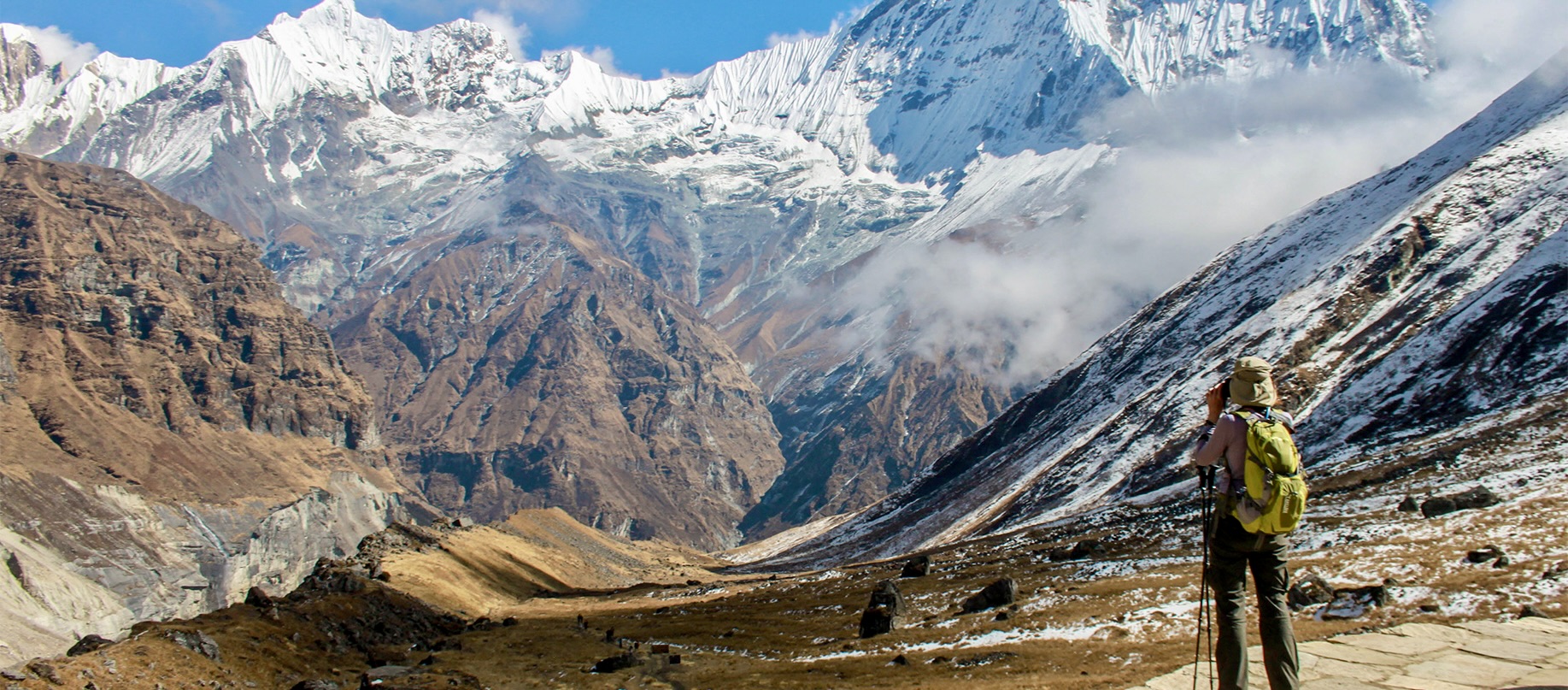
Why Stair Training Matters
- Mimicking the Terrain: The trail to Annapurna Base Camp is filled with steep ascents and descents. Much of the trek involves navigating stone steps carved out of mountain slopes. Training on stairs closely simulates these conditions.
- Strengthens Relevant Muscles: Regular stair training strengthens the quadriceps, hamstrings, calves, and glutes – the muscles you'll rely on most during your trek.
- Improves Cardiovascular Stamina: Continuous stair climbing is a cardio workout that helps increase your heart rate, enhancing your aerobic fitness and stamina, which is vital for high-altitude trekking.
- Reduces Injury Risk: By strengthening your leg muscles and improving coordination, you reduce the risk of strains, sprains, and other potential injuries on the trail.
Tips for Stair Training
- Start Slow: If you're new to stair training, start with short sessions and gradually increase your duration.
- Use Weight: To mimic the weight of your backpack, wear a backpack filled with weights or items. This not only builds strength but also helps you get used to carrying a loaded pack.
- Mix It Up: Alternate between walking, jogging, and running up the stairs to train different muscle groups and improve overall endurance.
- Include Descents: Don’t forget to practice going down the stairs. Descents can be just as challenging, if not more so, than ascents, especially when it comes to joint impact.
- Maintain Proper Form: Keep your back straight, engage your core, and ensure your entire foot lands on each step. Proper form minimizes the risk of injury.
- Incorporate Other Exercises: In addition to stair training, integrate squats, lunges, and calf raises into your routine to enhance muscle strength and flexibility.
While the concept might seem simple, stair training is a powerful tool in preparing for the Annapurna Base Camp trek. By simulating the challenges of the mountainous terrain and ensuring your body is ready for the ascent and descent, you significantly enhance your safety and enjoyment of the trek. Remember, Annapurna is not just about the destination; it's about the journey, and being physically prepared ensures that the journey is a memorable one.
Packing Lists for Annapurna Base Camp Trek
When trekking to the Annapurna Base Camp, your packing list is an essential part of ensuring your safety. A well-prepared trekker is less prone to unexpected issues. Here’s a comprehensive packing list to make sure you’re equipped for a safe trek to the ABC.
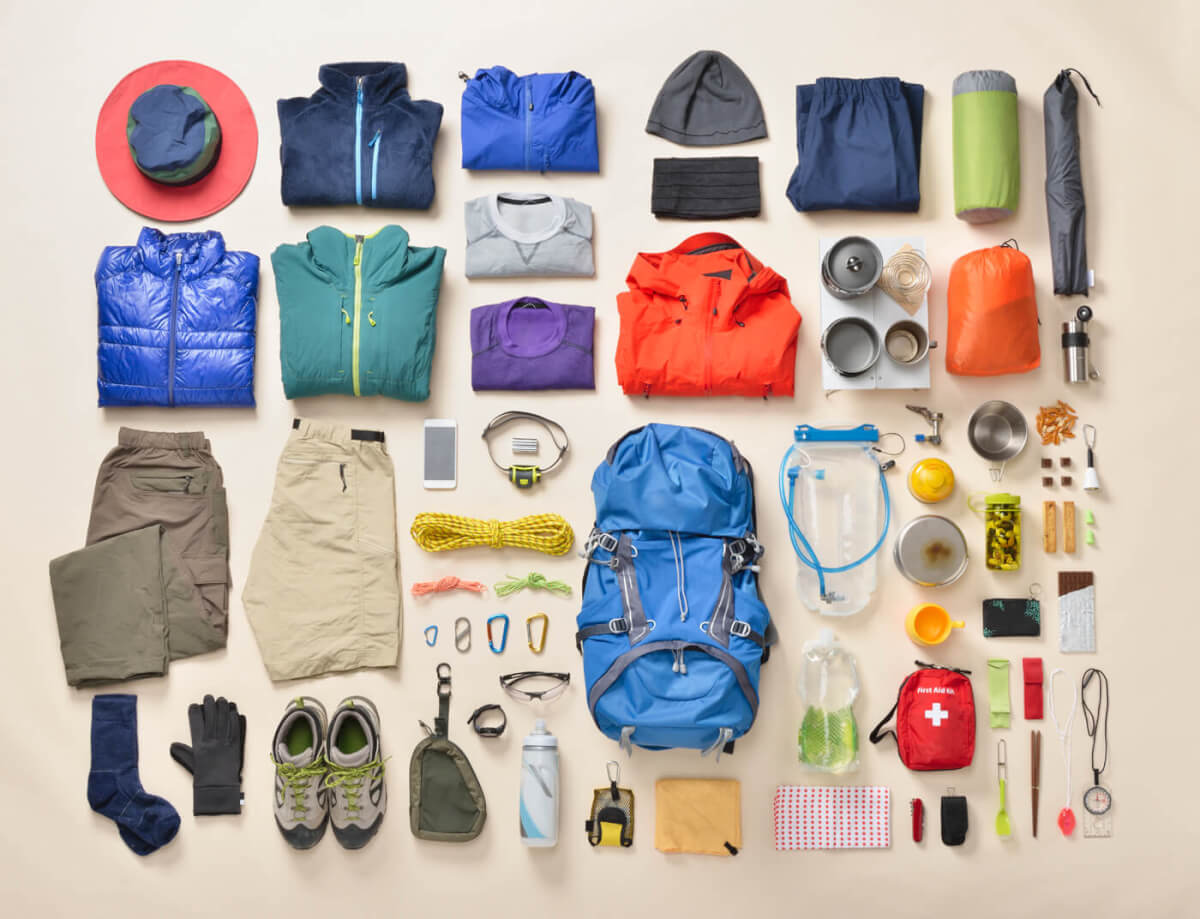
Essentials
- Trekking Permits: TIMS card and Annapurna Conservation Area Permit (ACAP).
- Passport and copies: Always keep your passport and a couple of photocopies with you.
- Map: A detailed map of the Annapurna region.
Clothing
- Base Layers: Moisture-wicking long-sleeve shirts and underwear.
- Insulating Layers: Fleece or woolen sweaters and pants.
- Outer Layers: Waterproof and windproof jackets and trousers. Consider a down jacket for colder conditions.
- Footwear: Sturdy, waterproof trekking boots and several pairs of trekking socks. Also, bring lightweight sandals or slippers for the evenings.
- Hats: A wide-brimmed hat for sun protection and a woolen hat for warmth.
- Gloves: Waterproof and insulated gloves.
Gear & Equipment
- Backpack: 50-70 liters with a rain cover.
- Sleeping Bag: Consider a four-season sleeping bag as temperatures can drop significantly at higher altitudes.
- Trekking Poles: Helpful for stability and reducing strain on the knees.
- Headlamp: With extra batteries.
- Sunglasses: UV protection sunglasses.
- Water Bottle or Hydration Bladder: At least 1-liter capacity.
Health & Safety
- First Aid Kit: Include band-aids, antiseptic wipes, blister plasters, pain relief, and altitude sickness medication.
- Personal Medications: Any prescribed medicines you take regularly.
- Water Purification Tablets or Steripen.
- Sunscreen & Lip Balm: With high SPF.
- Insect Repellent.
- Hand Sanitizer.
Miscellaneous
- Toiletries: Toothbrush, toothpaste, biodegradable soap, shampoo, and personal hygiene items.
- Small Towel.
- Reusable Cloth Bag: Useful for shopping in villages and minimizing plastic waste.
- Energy Bars & Snacks: For those moments when you need an energy boost.
- Camera & Binoculars: With extra batteries.
- Book or Journal.
Packing smart is crucial for safety and comfort. It ensures you're well-prepared for changing weather, potential health issues, and the rigors of the trek. Always remember to pack light, carrying only the essentials, as every extra kilogram can be felt after a day’s trek. Before you leave, check with a local trekking agency, like Luxury Holidays Nepal, for any specific recommendations or items you might have missed.
Monthwise Temperature of Annapurna Base Camp
Understanding the temperature variations months at Annapurna Base Camp (ABC) is imperative for a safe and pleasant trekking experience. Here's a detailed breakdown:
1. January: Daytime: -10°C to -5°C / Nighttime: -20°C to -14°C
Comments: January is the coldest month and sees a lot of snow. Many paths may be blocked. Ensure you have proper cold gear and are prepared for extreme cold.
2. February: Daytime: -7°C to -2°C / Nighttime: -18°C to -10°C
Comments: The cold remains intense, but the snow starts to decrease towards the end of the month, preparing for the pre-spring season.
3. March: Daytime: 0°C to 5°C / Nighttime: -8°C to -4°C
Comments: The spring trekking season starts, snow melts, and the temperature gradually becomes warmer. However, nights remain quite cold.
4. April: Daytime: 4°C to 10°C / Nighttime: -4°C to 0°C
Comments: One of the best months to trek with clear skies and moderate temperature. Flora starts blooming, adding beauty to the trails.
5. May: Daytime: 7°C to 12°C / Nighttime: -3°C to 2°C
Comments: Warm and pleasant, but the approaching monsoon can result in cloudy days towards the end of the month.
6. June: Daytime: 10°C to 16°C / Nighttime: 2°C to 6°C
Comments: The start of the monsoon season. Expect rainfall and leeches on lower altitudes. However, the rain often clears the sky, offering great views.
7. July: Daytime: 10°C to 15°C / Nighttime: 5°C to 10°C
Comments: Peak monsoon season, expect heavy rainfalls and slippery trails. Not the most popular month to trek.
8. August: Daytime: 10°C to 14°C / Nighttime: 4°C to 8°C
Comments: Rain continues but starts receding towards the end of August, preparing for the autumn trekking season.
9. September: Daytime: 8°C to 13°C/ Nighttime: 2°C to 7°C
Comments: One of the best times to trek with the end of monsoons, clear skies, and moderate temperatures.
10. October: Daytime: 5°C to 12°C / Nighttime: -3°C to 2°C
Comments: Peak trekking season. Expect clear views, but nights start getting colder.
11. November: Daytime: 0°C to 5°C / Nighttime: -7°C to -2°C
Comments: Early winter sets in. Days are colder, but the visibility remains clear.
12. December: Daytime: -5°C to 0°C / Nighttime: -14°C to -8°C
Comments: Cold and snowy, especially towards the end of the month. Proper winter gear is a must.
The monthly temperature variation gives trekkers an insight into what to expect and how to prepare. The best times to trek in terms of weather are during the pre-monsoon (April-May) and post-monsoon (September-October) seasons. However, if you enjoy solitude and are prepared for cold, winter treks can be quite serene.
Alternative Treks of Annapurna Base Camp Trek
The Annapurna region, blessed with diverse topography and cultural richness, offers more than just the popular Annapurna Base Camp trek. If you're looking for alternative treks in the region that offer equally stunning vistas without the crowd, here are some noteworthy options:
- Duration: 4-6 days
- Highlights: Offers panoramic views of Annapurna and Dhaulagiri mountain ranges. Best known for its sunrise view from Poon Hill. Suitable for those with limited time.
- Duration: 10-21 days
- Highlights: One of the classic treks in Nepal that goes around the Annapurna Massif. Crosses Thorong La Pass, the highest trekking pass in the world. Trekkers also get to experience diverse cultures, from Hindu villages at the low foothills to the Tibetan culture of Manang and Mustang.
- Duration: 4-7 days
- Highlights: A hidden gem in the Annapurna region. Less crowded and offers spectacular close-up views of the entire Annapurna range. Ideal for those seeking solitude.
Khayer Lake Trek
- Duration: 12-14 days
- Highlights: A mix of culture and nature, this trek is famous for Khayer Lake, which holds religious significance. Trekkers pass through beautiful Magar and Gurung villages.
Tilicho Lake Trek
- Duration: 10-12 days
- Highlights: Takes trekkers to the world’s highest lake, Tilicho Lake. Often combined with the Annapurna Circuit, it offers dramatic landscapes and a challenging trail.
Nar Phu Valley Trek
- Duration: 7-10 days
- Highlights: An off-the-beaten-path journey to the ancient Nar and Phu villages. Offers a blend of high peaks and high passes, glaciers, remote villages, narrow canyons, and lovely forests.
Khopra Danda Trek
- Duration: 7-10 days
- Highlights: A lesser-known trail that offers stunning panoramic views of the Annapurna and Dhaulagiri ranges. It also includes a visit to the beautiful Khayer Lake.
Jomsom Muktinath Trek
- Duration: 5-7 days if taking a flight to Jomsom
- Highlights: A part of the Annapurna Circuit, this trek is famous for the Muktinath Temple, a sacred site for both Hindus and Buddhists. The trail offers stark landscapes and views of the Annapurna and Dhaulagiri ranges.
While the Annapurna Base Camp trek is a bucket-list journey for many, the Annapurna region offers several alternative treks that are equally breathtaking. Depending on your interests, time, and physical capability, there’s always a trail in the Annapurna that will cater to your trekking desires.
Annapurna Base Camp Heli Trek
The Annapurna Base Camp Heli Trek is a popular option for those who want to experience the breathtaking beauty of the Annapurna Sanctuary but might be short on time or hesitant about the traditional trekking challenges.
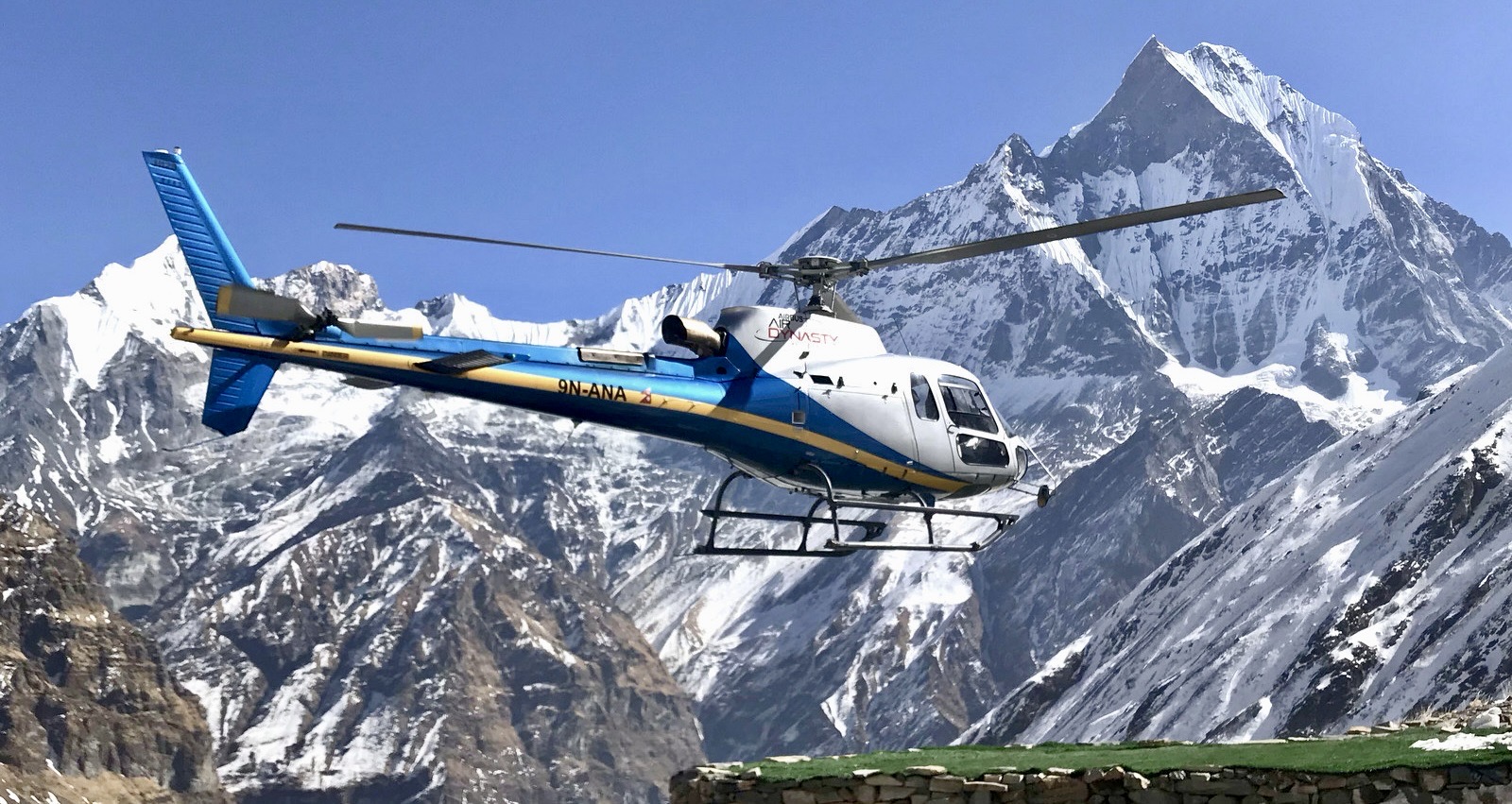
Here's what you need to know about the safety aspects of the Heli Trek:
Helicopter Safety Standards
- Luxury Holidays Nepal maintains high safety standards and only flies in suitable weather conditions.
- Pilots are experienced in navigating the Himalayan terrain.
- Always check the safety record of the helicopter company and ensure they are accredited.
Altitude Sickness
- The rapid ascent by helicopter can increase the risk of altitude sickness as there's less time for acclimatization.
- Ensure you are well-hydrated, get ample rest before the flight, and discuss any concerns with the heli crew or your guide.
Weather Concerns
- The Himalayan weather is unpredictable. Poor weather can lead to trip cancellations or delays.
- It's advisable to have flexible travel plans and be prepared for potential delays.
Landing and Take-off
- High-altitude landings can be a challenge due to thinner air and changing wind patterns. However, pilots are trained for such scenarios.
- Always listen to the crew's instructions during landing and take-off.
Health and Hygiene
- While the helicopter flight reduces trekking-related risks, you'll still need to ensure personal hygiene and consume safe food and water at the base camp.
- Carry a basic first-aid kit for any minor issues.
Environmental Considerations
- Helicopter flights can have environmental impacts, like noise pollution, which can disturb local wildlife.
- Choosing an eco-conscious company or limiting the frequency of such trips can help mitigate some of these effects.
Cost
- The Heli Trek is typically more expensive than traditional trekking. Ensure the price includes all safety measures, and there aren't hidden charges.
While the Annapurna Base Camp Heli Trek offers an unmatched and quick experience of the sanctuary, it's crucial to be informed and prepared for the distinct set of challenges it might present. Always prioritize safety and make decisions based on weather conditions, physical health, and the expertise of the professionals accompanying you.
Annapurna Base Camp Luxury Trek
Embarking on the Annapurna Base Camp Luxury Trek allows trekkers to experience the natural splendors of the Himalayas while enjoying an added layer of comfort and convenience.
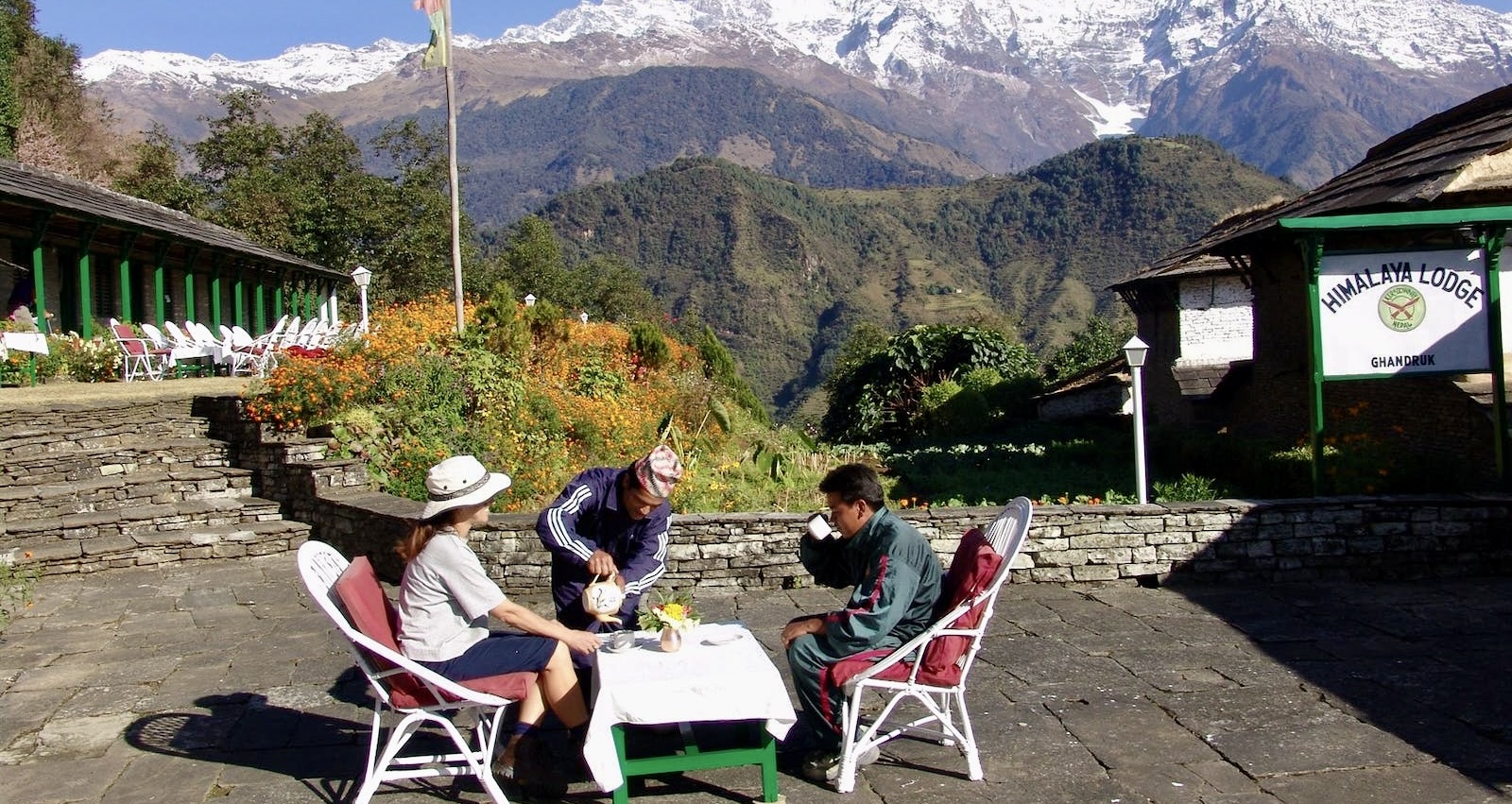
When considering safety, the luxury version of the trek presents its unique set of considerations:
Upgraded Accommodations
- Luxury lodges and teahouses offer more comfortable sleeping arrangements, enhanced amenities, and typically a higher standard of cleanliness.
- Better facilities reduce the risk of illnesses associated with hygiene and ensure a comfortable rest after trekking.
Professional Guides and Staff
- Luxury treks usually include highly experienced and trained guides who prioritize the safety and comfort of the trekkers.
- A smaller guide-to-trekker ratio often means more personalized attention, which can be crucial for detecting and addressing potential health issues early.
Diverse Menu Options
- Luxury trek packages often offer a wider variety of food choices, with more emphasis on hygiene, quality, and dietary needs.
- A nutritious, balanced diet is crucial in maintaining energy and health during treks.
Travel Insurance
- Highly recommend travel insurance for their clients, ensuring any emergencies can be addressed promptly and effectively.
Better Transportation Options
- Luxury treks may provide superior transportation options, from flights to private vehicles, reducing travel-related risks.
Advanced Medical Preparations
- Some luxury treks come with the added safety of carrying oxygen cylinders, a first-aid kit, and even medical personnel for the entire journey.
Environmental Responsibility
- Luxury treks often adopt sustainable practices, reducing the environmental footprint. Traveling with an eco-conscious company ensures a balance between luxury and care for the environment.
Higher Costs
- The enhanced services and amenities come at a higher price tag. It's important to ensure that the cost aligns with the quality of the services provided.
The Annapurna Base Camp Luxury Trek, curated by reputable providers like "Luxury Holidays Nepal", offers a safer and more comfortable alternative to standard treks. While the journey remains an adventurous endeavor, the luxury aspect ensures that risks are minimized, and trekkers can immerse themselves in the experience with peace of mind.
Trekking to the Annapurna Base Camp remains one of the most rewarding and transformative experiences that Nepal has to offer. However, like all high-altitude treks, it comes with its set of challenges. By understanding these challenges and preparing adequately, trekkers can significantly mitigate the risks involved.
The key to a safe and enjoyable Annapurna Base Camp trek lies in preparation. Being aware of potential altitude sickness symptoms, being respectful and knowledgeable about local customs, adhering to weather forecasts, and taking all necessary precautions related to wildlife and health can make all the difference. Hiring a knowledgeable guide can not only provide valuable insights into the region's culture and natural beauty but can also be a crucial factor in navigating the myriad challenges the trail might present.
Securing comprehensive trekking insurance is a wise decision, ensuring you have a safety net in case of unexpected events.
The beauty, culture, and sheer natural splendor of the Annapurna Base Camp trek await those who respect the journey and prepare well. With the right measures in place, it's not just a safe trek, but an unforgettable adventure that resonates long after the journey is over.
FAQs: Is it Safe to Trek to Annapurna Base Camp?
Q: Is the Annapurna Base Camp trek safe for solo travelers?
A: While many solo trekkers undertake the ABC trek, it's always safer to have a companion or join a group. If going solo, hiring a reputable guide is advisable.
Q: What are the main safety risks of the ABC trek?
A: The primary risks include altitude sickness, unpredictable weather changes, slippery trails during monsoons, and rare wildlife encounters. Preparedness and awareness can mitigate most of these risks.
Q: How can I prevent altitude sickness during the trek?
A: Proper acclimatization, staying hydrated, avoiding alcohol, and ascending gradually can help prevent altitude sickness. Listen to your body and descend if symptoms persist.
Q: Is the drinking water safe along the trek?
A: It's advisable to treat or purify water before drinking. You can use water purification tablets, or filters, or boil the water.
Q: Are there any dangerous animals to be aware of during the trek?
A: While encounters are rare, the Annapurna region is home to snow leopards, Himalayan black bears, and snakes. Sticking to the trail and trekking during daylight can avoid unwanted encounters.
Q: Do I need insurance for the Annapurna Base Camp trek?
A: Yes, comprehensive travel and trekking insurance that covers high-altitude trekking and possible emergency evacuations is strongly recommended.
Q: Is it safe for female trekkers?
A: The Annapurna region is generally safe for female trekkers. However, whether male or female, it's always safer to trek in groups or with a trusted guide.
Q: Are the lodges and teahouses secure for overnight stays?
A: Most of the lodges and teahouses along the ABC trail are safe and cater to international trekkers. Always keep your valuables close and lock your rooms when leaving.
Q: How do I deal with any medical emergencies during the trek?
A: There are health posts in some villages along the trail, but it's essential to carry a basic first-aid kit. In severe cases, an emergency helicopter evacuation might be necessary, which emphasizes the importance of good insurance.
Q: What's the best way to stay informed about the weather during the trek?
A: Hiring a knowledgeable guide can help, as they usually stay informed about weather conditions. There are also local radio updates and some mobile apps that offer weather forecasts for trekking regions.
Annapurna Region Trekking Packages
Annapurna Base Camp Trek - 15 Days
Annapurna Base Camp Trek - 10 Days
Ghorepani Poon Hill Trek - 10 Days
Mardi Himal Trek - 12 Days
Annapurna in Luxury- 11 Days
Annapurna Circuit Trek - 15 Days
Annapurna Base Camp Heli Trek - 9 Days
If you need any further information, please contact us by email: at [email protected], Phone: at +977- 985 100 5129 (WhatsApp)




